- Telephone: 508-795-3919
- Contact Us
- My Account • Dealer Log In
- Technical Support • Service Shipping
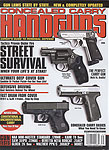
KAHR Perfect Pocket Pistols
Four different models-PM9, P9, CW9, T9-carried and shot!
Concealed Carry Handguns 2006, p.46-51
By Walt Rauch
 |
|
| Kahr Arms PM9, P9 and T9, front to rear. | |
 |
|
| Kahr now uses a lower-profile slide stop (top), compared to the original (bottom). | |
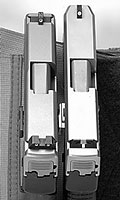 |
 |
| Tritium sights are a nice optional choice and fit the dovetail cuts in the P9 slide (left), the CW9 (right) has standard sights. | The Kahr P9 (left) and CW9 (right) have nicely tapered slides. |
Gun Details
The Kahr pistol is built entirely in the USA at the company's Worcester, MA manufacturing plant, using state-of- the-art machine equipment. Its action is based on a Browning-inspired locked-breech design and has a striker- operated firing pin, as well as a passive firing pin safety. There is no external hammer. When the trigger is pulled, the double-action mechanism draws back and then releases the striker. To re- strike a misfired chambered round, the slide must be retracted to re-set the striker.
Excluding this, the Kahr trigger works just like a double-action revolver, with a 3/8-of-an-inch trigger travel. Trigger pull weights on the Kahr T&E pistols I've tested ranged from six to almost seven pounds and all had a smooth trigger travel. And the Kahr is thin. For example, the slide width is .90 of an inch; in comparison, the subcompact GLOCK 26 slide is 1.25 inches thick.
The Kahr slide travels on four steel inserts or rails, two of which are inside the frame's dust cover, with the rear two at the extreme top back portion of the frame. The guns' weights range from 14-plus ounces to 27 ounces (unloaded), depending on their construction-all steel or polymer frame and steel slide.
The Kahr design has but two external moving parts: the slide stop and the magazine release. Both are on the left side of the frame-the slide stop just over the triggerguard and the magazine catch at the lower rear of the guard. There is no external manual safety. Overall, the pistols are nicely beveled.
Magazine capacities range from eight to six rounds, T9 to the K models. All the single-column magazines have steel bodies with cartridge witness holes on both sides and removable polymer or steel floor plates. Some have a "filler" around their lower portion to better allow their use in shorter frames by preventing over-insertion of the magazine. To further ensure reliability, the polymer magazine follower has a round metal plug inserted into the follower's left forward side. The metal insert, then, is the contact point with the slide stop, thus avoiding metal-to-polymer accelerated wear.
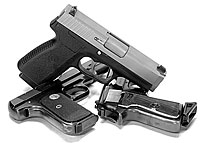
The P9 is the natural evolution from the Colt Pocket Model and the Walther PP Series pistols.

Kahrs disassemble easily into five parts.

The Kahr slide travels on four steel inserts.
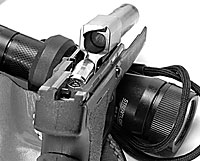
Kahr pistols have their feed ramp offset to the left, keeping the width size down.
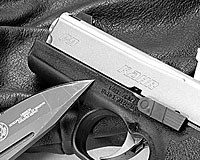
These faint "tic" marks must be aligned to remove the Kahr slide.

Kahr magazines, short to long.

The polymer frame has checkering for gripping, while the Hogue grips can be smooth or checkered.

The T9 and DeSantis Belt Slide holster with thumb-break; good for casual concealed carry.

The PM9 works well for pocket carry in a DeSantis Nemesis holster.

The author shoots the P9 from Galco's Elite leather fanny pack in an IDPA match.
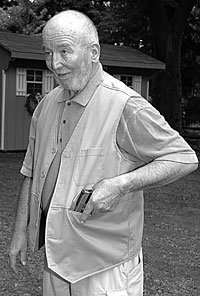
The Kahr pistol is easily concealed here in the Hidden Advantage vest from Concealed Carry Clothiers.
Hogue two-piece rubber grip panels are standard on the steel-frame guns, save for the T9, which has the otherwise- optional Hogue wooden grips as standard. The polymer frames have impressed checkering on front and back strap, with light stippling or pebbling on the grip flats.
The ramped front sight and rear square notch sight are dovetailed into the slide (except the CW9, which has a staked-in front sight). Windage adjustment is made with the rear sight and there's no elevation adjustment save for the T9 model, which has a fully adjustable rear sight. The standard front sight has a white-dot insert and the rear a white bar directly beneath the sight notch. Tritium sights are a factory option.
Breaking the gun down for cleaning is almost easy. All that's needed is to take the slide stop out to allow the slide assembly to be taken off the frame. Each of the Kahrs has faint "tic" marks on slide and frame that must be aligned to get the slide stop out. The "almost" comes, for me, in removing the slide stop. This should be a "no tool" operation, but I find I have to get something hard to push the pin out. (By the way, one criticism of the slide stop was that it was too wide. Kahr has addressed this and now the slide stop profile is much thinner.) The recoil spring and guide are removed and re-installed in the normal manner. (Reading the instruction book is the smart way to do this correctly.)
Back in 1995, Kahr had one gun- the K9 chambered in 9mm. Now in 2005, there are 32 models in 9mm and .40S&W (with the .45ACP P45 coming soon!). The plethora of model choices is achieved by mixing and matching of calibers, along with short and long slides coupled to standard and shortened steel or polymer frames. (There is no short slide/long frame version, however.)
When I first reviewed the Kahr pistol in 1995, I learned that company president, Dr. Justin Moon, designed the Kahr and was influenced by his admiration of both the SIG and the GLOCK pistols. This is quickly noticeable, for the Kahr slide resembles a GLOCK, while the frame mirrors the SIGARMS pistol and all Kahrs use a well-designed single-column magazine.
Dr. Moon's work since then has resulted in patents on the cocking cam, the striker and the manner in which the trigger is attached to the trigger bar, with other design patents pending. One very innovative idea was repositioning the feed ramp such that it's left of the bore line center, which allows the trigger drawbar to lie flatter against the right side of the frame. This allows for the narrow slide width mentioned earlier, that is 9/10 of an inch, the same as the Walther PP pistol. The frame is equally narrow.
Kahr Arms is following in some rather large footprints. The gold standard of pocket autos, for me, were the Colt pocket autos produced in the U.S. until the beginning of World War II, as well as the Walther PP Series handguns, with the Walther going Colt one better by having a double-action and single-action trigger system and a manual safety/decocker. (Certainly other handgun designs from the Golden Age of handguns may well equal if not surpass both Colt and Walther in features, but these two exemplars were the most widely used and respected.)
I've shot and written about a number of Kahr guns since 1995 and have always found each one to be reliable and accurate with all reputable brands of ammunition. There were a few glitches, though, when guns sent to me were pre-production samples. In one instance, the magazine catch was defective and in another, the recoil spring lost its strength within a few rounds. But both were simply defective parts that were quickly replaced.
After all the reviews, I still had not adopted any of them for my own regular use. To put it simply, I'm a believer in the old saw, "If it ain't broke, don't fix it." I've carried some sort of J-frame S&W revolver since 1958, with my S&W Model 42 Airweight Centennial being my everyday gun for the last quarter century. With it I know exactly what I can and can't do, so the Kahr, as well as my Seecamp and North American Arms pistols, are "sometimes" guns. In preparation for this article, however, I decided to see if I could be comfortable with the Kahr as a self-defense arm, prodded along in no small part by the unusually hot summer temperatures.
There are two more old saws that could apply here: "You can't teach an old dog new tricks" and "You're never too old to learn." I chose number two, stuffing the PM9 in a DeSantis Nemesis pocket holster, while filling a Galco Elite leather fanny pack with the P9, along with a spare magazine. (I took this opportunity to send my "traveling" J-frame, an S&W Model 642, to XS Sights for installation of a Big Dot Tritium front sight.)
My good intentions were to gradually make the changeover by carrying both guns and rigs along with me when I went to the range with other guns and shoot them at the end of whatever my main purpose was for the trip. I was looking to come to the same level of reflexive familiarity I have with the M42 and my 1911s. I knew the Kahrs were good to go, but I passed over them for regular carry because I wanted the mental comfort afforded by my old standbys.
Things didn't happen the way I planned, though. I stopped by a local IDPA match to visit and take some photos, but not to shoot. Due to the weather, I had the P9 in the Galco Elite fanny pack, along with a spare magazine, both loaded with CCI Gold Dot 124-grain +P+ HP loads. (The S&W M42 was in my pocket-just in case.)
IDPA Shooting
When I arrived, the match was almost over but one of the Safety Officers asked if I'd like to shoot one of the stages. My first instinct was to say no, because I didn't have a "real" gun for the match. I then had to admit that what I was really thinking was that I would not do very well with the P9. So, admitting the only thing I had to injure was my pride, I filled a third magazine with Remington UMC 115-grain FMJ ammo and set to seeing just how I would do; definitely not a good attitude, but I rationalized that this would be a good test. And as it turned out, it was.
The stage was a modified El Presidente that required two shots on each of three targets with two reloads. It was an abrupt and enlightening learning experience to be sure, and I discovered a few things very quickly. I saw I needed much more practice drawing from a fanny pack, that the P9 shot high for me, and my slide-lock magazine changes needed practice. I also didn't get a good grip on the thin polymer frame. After this questionable performance, I was fortunate in that another Safety Officer asked if I wanted to shoot the last stage.
Wanting to redeem myself, I borrowed some Winchester White Box 147-grain FMJ ammo (thanks, Joe MacAfee!) and managed to draw a bit smoother, shoot lower and not drop magazines. (My hits were better too!) This quick and dirty use of the P9 also reconfirmed that solitary range practice doesn't and will not cut it for me, revalidating that shooting IDPA and IPSC events can truly be "a test of defensive skills in a sporting environment."
I've now carried and worked out on the range with four Kahrs-the T9, the P9, the CW9 and the PM9-using a variety of holsters including belt slides and ankle rigs, as well as the two others already mentioned, and find that I'm getting quite comfortable using Kahr pistols-almost. I won't walk away from my long-time friends, but they can now have good company! Kahr Arms has dealer locator information and company history, as well as parts and accessories such as holsters and where to find them, on their website.
Accuracy: Kahr P9 9mmInasmuch as I've been shooting the Kahr pistols since 1995, I've found that, depending on my ability on any given day, they all will put five rounds of quality ammunition into three inches or less at 25 yards firing from a gun bag rest, so I did not fire all of the loads for group. I did re-fire the Remington UMC 115-grain and the Winchester 147-grain Ranger SXT loads at 25 yards using the P9, because I practice with the 115-grain loads and carry the Kahr with both light and heavy bullet weights. I reconfirmed that the pistol is "overbuilt," for it will deliver more accuracy than can reasonably be expected to be needed for self-defense |
Performance: Kahr Arms P9 9mm |
||||||||||||||||||||||||||||||
|
||||||||||||||||||||||||||||||
| Bullet weight measured in grains, velocity in feet per second (fps). Shot over a Competition Electronics Pro-Chrono chronograph. Temperature 94 degrees Fahrenheit, elevation 300 feet above sealevel. |
